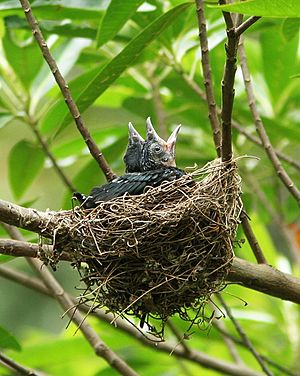Spangled drongo facts for kids
Quick facts for kids Spangled drongo |
|
|---|---|
 |
|
| Conservation status | |
| Scientific classification | |
| Genus: |
Dicrurus
|
| Species: |
bracteatus
|
The spangled drongo (Dicrurus bracteatus) is a cool bird from the Dicruridae family. It's the only drongo bird you'll find in Australia. You can spot it by its shiny black feathers and its special forked tail. This bird loves to eat insects and small animals. It makes many different and interesting sounds, and it's also amazing at copying noises it hears! Spangled drongos arrive in Queensland in late spring. They build their nests high up in a single tree and usually have three to five young birds each year.
Contents
What Does the Spangled Drongo Look Like?
This bird's feathers are mostly black. But they have a cool, shiny look with hints of blue and purple, like a rainbow! Its eyes are a bright red color.
The most amazing thing about how it looks is its tail. It's long and curves outwards, splitting into a fork. At first glance, it might even look like its tail feathers are crossed over, just like when you cross your fingers! Young drongos don't have these shiny colors or spots, and their eyes are a dark brown.
How Does the Spangled Drongo Behave?
The spangled drongo acts in a very free and sometimes funny way. It swoops and lands on branches while looking for food. It eats insects, small birds, and even tiny lizards. When these birds visit towns and cities during certain seasons, they can become quite friendly. If you throw small pieces of raw meat into the air, they will fly down perfectly to catch them in mid-air!
Even though this bird is often quiet, it can sometimes make incredibly loud and fun calls. Some of its sounds might even make you think it's "sneezing"!
Amazing Mimicry
The spangled drongo is an incredible mimic. This means it can copy sounds! It learns most of its "words" from the noises it hears around it. Then, it weaves these sounds into an amazing song, almost like a talented singer.
Where Do Spangled Drongos Live and How Do They Reproduce?
The spangled drongo is the only type of drongo bird found in Australia. These birds move around a lot. They travel to different heights and places depending on the season. For example, in the high areas around Brisbane in Queensland, they arrive in late spring. They leave in mid-summer with their new young birds.
Their nests are shaped like cups and are built in open spots. This makes it hard for other animals that might want to eat their eggs or young to get to them without being seen. The nests are usually built very high up in the trees, about 75% of the way to the top. Each year, a pair of spangled drongos will usually have three to five young birds.
Fun Fact: The Word "Drongo"
There was once a racehorse that didn't win many races. It was named Drongo after this bird. Because the horse wasn't very successful, the word "drongo" became a slang term in Australia. It's used to call someone an "idiot" or "silly."
See also
 In Spanish: Drongo escamoso para niños
In Spanish: Drongo escamoso para niños



